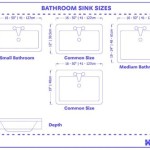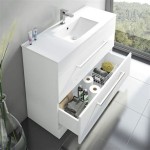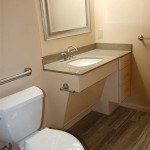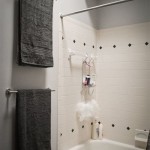How To Clear A Slow-Draining Bathroom Sink Drain
A slow-draining bathroom sink is a common household nuisance. It can stem from a variety of causes, ranging from simple hair accumulation to more complex plumbing issues. Addressing this problem promptly is essential to prevent complete blockage and potential water damage. This article outlines several methods for clearing a slow-draining bathroom sink, progressing from the simplest solutions to more involved techniques.
Identifying The Cause of the Slow Drain
Before attempting any solution, it's crucial to understand the possible causes of the slow drain. The most frequent culprit is a buildup of hair, soap scum, and toothpaste residue within the drainpipe. These materials combine to form a sticky, obstructive mass that restricts water flow. Other potential causes include:
*Mineral Deposits:
Hard water contains minerals like calcium and magnesium that can accumulate inside pipes, narrowing the diameter and impeding drainage. *Foreign Objects:
Small items such as jewelry, small toothbrush parts, or even small plastic toys can inadvertently fall into the drain and cause a blockage. *Pipe Corrosion:
Over time, older pipes can corrode internally, creating rough surfaces that trap debris and slow water flow. This is less common in newer plumbing systems. *Ventilation Issues:
A blocked plumbing vent can create a vacuum in the drainpipe, hindering the flow of water. This is usually indicated by multiple slow drains in the house. *Grease and Oil:
While less common in bathroom sinks than in kitchen sinks, grease and oil from certain cosmetic products can solidify and contribute to drain blockage.Once a general understanding of potential causes is established, it becomes easier to select and implement the most appropriate clearing method.
Simple First Steps: Hot Water Flush and Plunger
Often, a simple flush with hot water can dislodge minor blockages. The heat can help to dissolve soap scum and loosen accumulated debris. Follow these steps:
1. Remove the stopper from the sink drain. 2. Run hot water from the tap for several minutes. Let the hot water run at the hottest setting your faucet allows for at least 5-10 minutes. 3. Observe if the drain flow improves.If the hot water flush is insufficient, a plunger can be used to create pressure and suction that can dislodge the blockage. Proper plunger technique is essential for effectiveness:
1. Ensure there is enough water in the sink to cover the cup of the plunger. Add water if necessary. 2. Create a tight seal between the plunger cup and the drain opening. 3. Push and pull the plunger vigorously for several minutes, maintaining the seal. 4. Remove the plunger and observe if the drain flow has improved. 5. Repeat the process several times if necessary.For sinks with an overflow drain, it's important to block the overflow opening with a wet cloth or tape while plunging to maximize the pressure directed at the main drain.
Using Natural Cleaning Solutions: Baking Soda and Vinegar
A mixture of baking soda and vinegar is a natural and effective alternative to harsh chemical drain cleaners. The chemical reaction between the two creates a fizzing action that can break down and dislodge accumulated debris. Here’s how to use it:
1. Remove standing water from the sink. 2. Pour about one cup of baking soda down the drain. 3. Follow with one cup of white vinegar. 4. Let the mixture fizz and bubble for approximately 30 minutes. The fizzing action helps to break down the grime and unclog the drain. 5. Flush the drain with hot water for several minutes to wash away the loosened debris.Repeating this process a couple of times may be necessary for stubborn clogs. This method is less likely to damage pipes compared to chemical drain cleaners.
Disassembling the Drainpipe: Cleaning the P-Trap
The P-trap is the curved section of pipe located under the sink. It is designed to trap debris and prevent sewer gases from entering the house. This is often where clogs accumulate, making it a prime target for cleaning. Follow these steps to disassemble and clean the P-trap:
1. Place a bucket under the P-trap to catch any water and debris that may spill out. 2. Loosen the slip nuts that connect the P-trap to the drainpipe and the tailpiece (the pipe leading down from the sink). 3. Carefully remove the P-trap. 4. Inspect the P-trap for any blockage. Remove any visible debris, such as hair, soap scum, or foreign objects. 5. Rinse the P-trap thoroughly with water to remove any remaining residue. A small brush or tool can be used to scrub the inside of the trap. 6. Reassemble the P-trap, ensuring that the slip nuts are tightened securely but not overtightened. 7. Run water into the sink to check for leaks. If leaks are present, tighten the slip nuts further.If the P-trap is severely corroded or damaged, it may need to be replaced. Replacement P-traps are readily available at most hardware stores.
Using a Drain Snake (Plumbing Snake)
A drain snake, also known as a plumbing snake, is a flexible tool used to break up and remove stubborn clogs that are located further down the drainpipe. It consists of a long, flexible cable with a corkscrew or auger at the end. To use a drain snake:
1. Insert the end of the drain snake into the drain opening. 2. Feed the snake down the drainpipe, rotating the handle to help it navigate the bends. 3. When you encounter resistance, continue rotating the handle to break up or hook the clog. 4. Carefully pull the drain snake back out, removing the debris that is attached to it. 5. Repeat the process until the drain flows freely. 6. Flush the drain with hot water to clear any remaining debris.Different types of drain snakes are available, ranging from small hand-operated versions to larger, motorized models. For a bathroom sink drain, a smaller hand-operated snake is usually sufficient.
Checking the Sink Stopper Mechanism
Sometimes, the slow drain is not caused by a clog in the drainpipe itself, but rather by a malfunctioning sink stopper mechanism. The stopper mechanism is the assembly of rods and levers that controls the pop-up stopper in the sink. Over time, hair and debris can accumulate around the stopper mechanism, obstructing the flow of water. To check and clean the stopper mechanism:
1. Locate the pivot rod, usually located beneath the sink, connected to the tailpiece. 2. Remove the pivot rod nut, if present. 3. Pull out the pivot rod. 4. Remove the stopper from the sink. 5. Clean the stopper and the pivot rod of any accumulated hair, soap scum, and debris. 6. Inspect the stopper and the pivot rod for any damage. 7. Reassemble the stopper mechanism, ensuring that the stopper moves freely. 8. Test the drain flow to see if the problem is resolved.If the stopper is significantly damaged, it may need to be replaced. Stopper replacement kits are available at most hardware stores.
Addressing Mineral Buildup
In areas with hard water, mineral deposits can accumulate inside the drainpipe, gradually narrowing the diameter and restricting water flow. While baking soda and vinegar can help to dissolve some mineral buildup, stronger solutions may be necessary for more severe cases.
Commercial descaling products are available that are specifically designed to dissolve mineral deposits. These products typically contain acids that react with the mineral deposits, breaking them down. Always follow the manufacturer's instructions carefully when using these products, as they can be corrosive and may damage certain types of pipes. Another approach is to use a more concentrated vinegar solution. Pour a cup of undiluted white vinegar down the drain and let it sit for several hours, or even overnight, before flushing with hot water.
For severe mineral buildup, professional plumbing services may be required to thoroughly clean or replace the affected pipes.
Preventive Measures to Maintain a Clear Drain
Preventing clogs is always better than dealing with a slow-draining sink. Several preventive measures can be taken to minimize the accumulation of debris in the drainpipe:
*Use a drain strainer:
A drain strainer is a small mesh screen that fits over the drain opening and catches hair and other debris before they enter the drainpipe. Regularly cleaning the strainer is essential. *Flush with hot water regularly:
Regularly flushing the drain with hot water can help to dissolve soap scum and prevent the buildup of debris. *Avoid pouring grease or oil down the drain:
Grease and oil can solidify and contribute to drain blockages. Dispose of these materials properly. *Periodically clean the stopper mechanism:
Regularly cleaning the stopper mechanism can prevent the accumulation of hair and debris that can obstruct water flow. *Consider a maintenance dose of baking soda and vinegar:
A monthly treatment of baking soda and vinegar can help to keep the drainpipe clear.By implementing these preventive measures, the frequency of slow-draining sinks can be greatly reduced.
When to Call a Professional Plumber
While many slow-drain issues can be resolved with the methods described above, some situations warrant the expertise of a professional plumber. These include:
*Persistent clogs:
If you have tried multiple methods to clear the drain, but the problem persists, it may indicate a more serious blockage or a problem deeper within the plumbing system. *Recurring clogs:
If your sink frequently clogs, there may be an underlying issue that needs to be addressed, such as a partially collapsed pipe or a problem with the plumbing vent. *Multiple slow drains:
If multiple drains in your house are slow, it may indicate a problem with the main sewer line. *Suspected pipe damage:
If you suspect that the pipes are damaged, it is best to call a professional plumber to avoid further damage. *Lack of experience:
If you are not comfortable working with plumbing or are unsure about any of the steps involved, it is always best to call a professional plumber.A professional plumber has the tools and expertise to diagnose and resolve complex drain problems safely and effectively. They can also identify and address any underlying plumbing issues that may be contributing to the problem.

How To Unclog A Bathroom Sink Hana S Happy Home

How To Unclog A Slow Draining Bathroom Sink

How To Unclog A Slow Running Bathroom Sink Drain 10 Options

How To Unclog A Slow Running Bathroom Sink Drain 10 Options

How To Unclog A Bathroom Sink Hana S Happy Home

5 Natural Ways To Unclog A Bathroom Sink Hiller How

How You Can Fix A Slow Draining Drain On Your Own Ashton Plumbing Heating Air Conditioning

How To Unclog Clean A Bathroom Sink Drain 3 Methods

How To Fix A Slow Draining Or Clogged Bathroom Sink

5 Causes Of Slow Bathroom Sink Drain And Fixes Frank S Repair Plumbing







